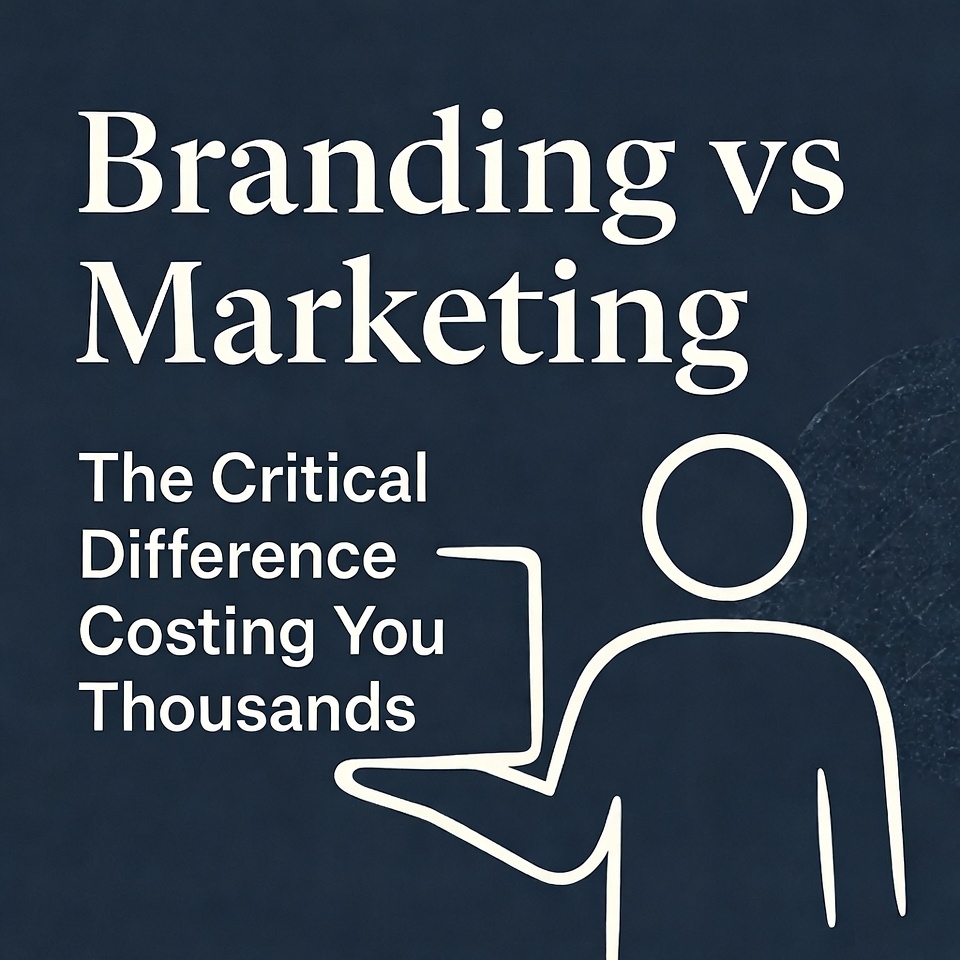The $50,000 Mistake Most Business Owners Make
Picture this: You’ve just spent $50,000 on a flashy marketing campaign. The ads are running, the clicks are coming in, but six months later… crickets. Sales plateau. Customer loyalty? Non-existent.
Sound familiar?
Here’s the hard truth: You’ve been treating marketing like a band-aid when your business needed surgery.
The problem isn’t your marketing tactics. It’s that you’ve confused marketing with branding—and that confusion is hemorrhaging your budget faster than you can say “conversion rate.”
🎯 What You’ll Learn in This Guide
By the end of this article, you’ll understand:
- The fundamental difference between branding and marketing (and why it matters)
- Why marketing without branding is like selling a car with no engine
- The exact framework to build both strategically
- Real-world examples from companies that got it right (and wrong)
- How to calculate the ROI of branding vs marketing spend
Part 1: The Core Distinction That Changes Everything
What Is Branding?
Branding is who you are. It’s your business’s identity, personality, and promise distilled into every touchpoint.
Think of branding as your reputation in physical form. It’s:
- Your core values – What you stand for when no one’s watching
- Your visual identity – Logo, colors, typography, design language
- Your voice and tone – How you communicate across all channels
- Your positioning – The unique space you own in customers’ minds
- Your customer experience – Every interaction from discovery to post-purchase
- Your story – The narrative that makes people care
Key insight: Branding happens whether you actively manage it or not. The question is: are you shaping it intentionally, or letting it form by accident?
What Is Marketing?
Marketing is what you do. It’s the tactical execution that gets your brand in front of people and converts them into customers.
Marketing includes:
- Advertising campaigns – Paid media across channels
- Content marketing – Blog posts, videos, podcasts
- Social media marketing – Daily engagement and community building
- Email marketing – Nurture sequences and promotions
- SEO and SEM – Organic and paid search strategies
- Public relations – Media outreach and coverage
- Events and sponsorships – Physical and virtual brand presence
Key insight: Marketing amplifies your brand. Without a strong brand foundation, marketing is just noise competing with everyone else’s noise.
Part 2: The Relationship That Multiplies Results
Why Branding Comes First
Imagine trying to sell a luxury watch with discount store packaging. Or positioning yourself as an eco-friendly brand while using wasteful production methods.
The disconnect destroys trust instantly.
Here’s the hierarchy that successful companies follow:
1. Brand Strategy → Define who you are 2. Brand Identity → Create how you look and sound
3. Marketing Strategy → Plan how to reach people 4. Marketing Tactics → Execute campaigns that convert
Skip steps 1 and 2, and steps 3 and 4 become exponentially more expensive and less effective.
The Compounding Effect of Getting It Right
When branding and marketing work in harmony:
✅ Marketing costs decrease – Strong brands require less convincing
✅ Customer lifetime value increases – People stay loyal to brands they connect with
✅ Word-of-mouth multiplies – Brands with clear identities are easier to recommend
✅ Premium pricing becomes possible – Brand equity justifies higher prices
✅ Hiring gets easier – Top talent wants to work for compelling brands
Part 3: Real-World Case Studies
🏆 Success Story: Apple’s Branding-First Approach
The Branding Foundation:
- Brand promise: “Think Different”
- Core value: Innovation that empowers creativity
- Visual identity: Minimalist, premium, instantly recognizable
- Customer experience: Seamless ecosystem across products
The Marketing Execution:
- Product launches become cultural events
- Advertising focuses on lifestyle, not features
- Retail stores are brand temples, not just sales floors
The Result: Apple commands 40%+ profit margins in competitive markets where others fight over single digits.
⚠️ Cautionary Tale: Pepsi’s Logo Redesign Disaster
The Mistake: In 2008, Pepsi spent $1 million on a logo redesign and $100+ million rolling it out—without addressing fundamental brand positioning issues.
What Went Wrong:
- Marketing spend couldn’t overcome weak brand differentiation vs. Coca-Cola
- Visual changes without strategic brand evolution
- Confused messaging that failed to resonate
The Lesson: You can’t design your way out of a brand strategy problem.
🚀 Modern Example: Airbnb’s Rebrand Success
The Strategic Shift:
- From “cheap accommodation” to “belong anywhere”
- Unified brand identity with the “Bélo” symbol
- Consistent experience across all touchpoints
- Marketing that tells human connection stories
The Result: Brand value increased from $25.5 billion (2018) to $75+ billion (2024), despite economic challenges.
Part 4: The Financial Reality Check
The Hidden Costs of Marketing Without Branding
Let’s break down what poor branding actually costs:
| Metric | Weak Brand | Strong Brand | Your Lost Revenue |
|---|---|---|---|
| Customer Acquisition Cost | $200 | $100 | 50% waste per customer |
| Customer Lifetime Value | $500 | $2,000 | 75% unrealized potential |
| Churn Rate | 40% | 15% | 25% revenue leak |
| Marketing ROI | 2:1 | 6:1 | 3x less efficient |
| Premium Pricing Power | 0% | 20-50% | Massive margin loss |
For a business spending $100K annually on marketing with weak branding:
- Actual effective spend: ~$40K
- Wasted budget: ~$60K
- Lost lifetime value: $150K+
- Total opportunity cost: $210,000+ per year
Part 5: Your Strategic Framework
Phase 1: Build Your Brand Foundation (Months 1-3)
Step 1: Define Your Brand Strategy
- Conduct competitive analysis
- Identify your unique positioning
- Articulate your brand purpose and values
- Create your brand messaging architecture
Step 2: Develop Your Brand Identity
- Design visual identity system
- Establish voice and tone guidelines
- Create brand experience standards
- Document everything in a brand guide
Step 3: Align Internal Culture
- Train team on brand values
- Ensure operational alignment
- Create brand ambassadors internally
Investment Range: $15,000 – $100,000 depending on complexity
Phase 2: Deploy Strategic Marketing (Months 4-12)
Step 1: Content Marketing
- Launch brand-aligned blog and content hub
- Create pillar content that establishes authority
- Develop content distribution strategy
Step 2: Digital Presence
- Optimize website for brand experience and conversions
- Build social media presence consistently
- Implement SEO strategy aligned with brand positioning
Step 3: Paid Acquisition
- Launch targeted ad campaigns
- Test messaging variants
- Optimize for conversion and lifetime value
Step 4: Measure and Refine
- Track brand awareness metrics
- Monitor sentiment and perception
- Calculate true marketing ROI
- Iterate based on data
Investment Range: $30,000 – $500,000+ annually depending on scale
Part 6: Common Mistakes That Kill Results
❌ Mistake #1: Logo = Brand
The Reality: Your logo is a symbol of your brand, not the brand itself. Changing your logo without addressing deeper brand strategy issues is like rearranging deck chairs on the Titanic.
❌ Mistake #2: Marketing Can Fix a Weak Brand
The Reality: No amount of marketing spend can overcome a poorly positioned brand. You’ll just burn through cash faster while competitors with strong brands spend less for better results.
❌ Mistake #3: Branding Is Just for Big Companies
The Reality: Small businesses need branding MORE than big companies because they have fewer resources to waste on inefficient marketing. Strategic branding makes every dollar work harder.
❌ Mistake #4: Copying Competitors’ Marketing Tactics
The Reality: Tactics that work for one brand fail for another because the underlying brand foundation is different. Focus on YOUR unique brand position, not mimicking others.
❌ Mistake #5: Inconsistent Brand Experience
The Reality: Your brand is the SUM of all customer touchpoints. One bad experience can undo thousands in marketing spend. Consistency compounds trust.
Part 7: Quick Assessment Tool
Is Your Brand Costing You Money?
Answer these questions honestly:
Brand Strategy:
- Can you articulate your brand positioning in one sentence?
- Do you know your brand values and use them to make decisions?
- Is your customer experience deliberately designed to reflect your brand?
Brand Identity:
- Is your visual identity consistent across all channels?
- Do you have documented brand guidelines?
- Does your brand look and feel distinct from competitors?
Brand-Marketing Alignment:
- Does all marketing content reflect your brand voice?
- Can customers easily understand what makes you different?
- Are you measuring brand metrics, not just marketing metrics?
Score:
- 7-9 checkmarks: Strong foundation—optimize and scale
- 4-6 checkmarks: Moderate foundation—strategic improvements needed
- 0-3 checkmarks: Weak foundation—brand work is urgent priority
Part 8: Action Plan for Maximum ROI
For Businesses With <$50K Marketing Budget
Priority: Brand Foundation First
- Invest 60% in brand strategy and identity development
- Use 40% for targeted, brand-aligned marketing tests
- Focus on organic channels that compound over time
- Build brand equity before scaling paid acquisition
Timeline: 6-12 months to establish foundation
For Businesses With $50K-$250K Marketing Budget
Priority: Balanced Approach
- Allocate 30% to brand development and refinement
- Use 70% for marketing execution across multiple channels
- Implement brand tracking alongside marketing metrics
- Scale what works while maintaining brand consistency
Timeline: 3-6 months to see momentum
For Businesses With $250K+ Marketing Budget
Priority: Optimization and Scale
- Invest 20% in continuous brand evolution
- Deploy 80% in sophisticated marketing orchestration
- Build brand management team or partner
- Leverage brand equity for market expansion
Timeline: Ongoing optimization cycle
The Bottom Line: Stop Leaving Money on the Table
Here’s what most business owners miss: branding isn’t an expense—it’s a multiplier.
Every dollar you invest in building a strong brand foundation multiplies the effectiveness of every marketing dollar you spend afterward.
The companies winning in your market aren’t spending more on marketing—they’re spending smarter because their brand does half the heavy lifting.
Your Next Step
Ask yourself: “Are we building a brand people remember, or just running campaigns people ignore?”
If you can’t immediately answer what makes your brand different, valuable, and memorable—that’s your answer. The difference between branding and marketing isn’t academic. It’s the difference between burning cash and building equity.
The choice is yours. But the market won’t wait.
Key Takeaways
💡 Branding is strategic (who you are) – Marketing is tactical (what you do)
💡 Strong brands reduce marketing costs by 40-60% over time
💡 Marketing without branding is 3x less efficient and unsustainable
💡 Brand building compounds – early investment pays dividends for years
💡 The biggest mistake is treating symptoms (poor marketing results) instead of the disease (weak brand foundation)
Frequently Asked Questions
Q: How long does it take to build a strong brand?
A: Foundation work takes 3-6 months. Building brand equity in the market takes 12-36 months of consistent execution.
Q: Can I build a brand with a small budget?
A: Absolutely. Strategic thinking costs nothing. Start with positioning and messaging, then build visual identity as budget allows.
Q: Should I rebrand or just improve marketing?
A: If your positioning is unclear or your identity feels inconsistent, address branding first. If your brand foundation is solid but results are poor, optimize marketing.
Q: How do I measure brand ROI?
A: Track brand awareness, consideration, preference, and loyalty alongside traditional metrics like CAC, LTV, and retention rates.
Q: What’s the difference between brand positioning and marketing positioning?
A: Brand positioning is the long-term space you own in customers’ minds. Marketing positioning is how you frame specific offers or campaigns within that broader brand context.
Ready to stop wasting money on marketing that doesn’t work? Start by auditing your brand foundation. The returns might surprise you.











